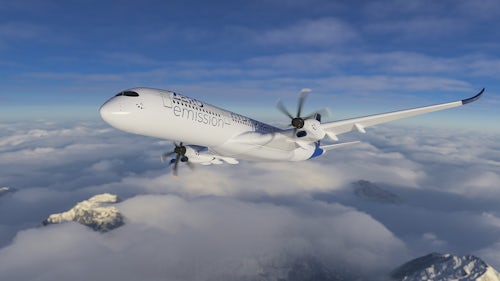Innovieren Sie das Flugzeug der Zukunft: Neue Ansätze beim Flugzeugbau der nächsten Generation
Im Zuge der Notwendigkeit, die CO2-Emissionen zu senken, hat sich die Elektrifizierung zu einem Haupttrend in der Luftfahrtbranche entwickelt. Um die Flugzeuge der Zukunft zu entwickeln, wie beispielsweise Flugzeuge mit Elektroantrieb und wasserstoffbetriebene Flugzeuge, sind innovative Technologien und Prozesse erforderlich.
Dieses Whitepaper erläutert die Herausforderungen, mit denen Luftfahrtingenieure konfrontiert sind. Es erklärt, wie die modellbasierte Systementwicklung (MBSE) Hersteller und ihre Zulieferer dabei unterstützt, das Flugzeug der Zukunft zu entwickeln.
Informieren Sie sich, wie Sie einen umfassenden digitalen Zwilling für das Performance-Engineering einsetzen, die Verhaltensverifikation und -validierung durch die Nutzung realistischer Simulationen erleichtern und die mit der Konstruktion verbundenen Herausforderungen durch die Auflösung von Silos zwischen den verschiedenen Fachgebieten effektiv bewältigen.
Erfahren Sie, wie die Elektrifizierung den Entwicklungsprozess des Flugzeugs der nächsten Generation transformiert
In diesem Whitepaper erfahren Sie, wie Sie die technischen Herausforderungen der Elektrifizierung bei der Entwicklung in den Griff bekommen – Herausforderungen, die sich wiederum auf den Entwicklungsprozess auswirken. Es enthält konkrete Beispiele, die veranschaulichen, wie ein modellbasiertes System Engineering-Konzept das Wärmemanagement des Flugzeugs und die Integration des elektrischen Systems innoviert. Dabei wird ein umfassender digitaler Zwilling verwendet, um eine Entwicklung in dezentralen Strukturen zu vermeiden.
So überdenken Sie Ihren Flugzeug-Performance-Engineering-Prozess
Die Entwicklung der Leistungsmerkmale der Flugzeuge der nächsten Generation stellt eine Herausforderung dar. Viele Stakeholder sind bereits in den frühen Entwicklungsphasen am endgültigen Konstruktionsentwurf beteiligt. Agieren diese Stakeholder isoliert voneinander und kommunizieren sie statisch und dokumentenbasiert, kann niemand einen klaren Überblick über die integrierte und dynamische Systemleistung gewinnen.
Kurz gesagt können skalierbare und kollaborative Tools für dynamisches modellbasiertes Systems Engineering die Simulation, Optimierung und die Tests des physischen Verhaltens zukünftiger Flugzeuge unterstützen. Sehen Sie sich das kurze Video an und erschließen Sie das Potenzial des digitalen Zwillings für integriertes und dynamisches Performance Engineering.
Hersteller implementieren modellbasiertes Systems Engineering in aktuelle und zukünftige Flugzeugkonstruktionen: Anwenderbericht von Airbus Helicopters
Erfahren Sie, auf welche Weise Hersteller die Technologie bereits implementiert haben. In diesem Anwenderbericht erläutern Stéphane Amerio und Franck Nicolas von Airbus Helicopters, wie sie das Konzept des modellbasierten Systems Engineerings nutzen, um den Konstruktionszyklus von Kraftstoffsystemen für moderne Hubschrauber zu beschleunigen. Lesen Sie den Anwenderbericht.
Erfahren Sie mehr: Welche Auswirkungen elektrifizierte Flugzeugantriebe auf Konstruktionsprozesse haben
Durch den Elektroantrieb für die Flugzeugkonstruktion erweitert sich der Konstruktionsraum. Ingenieure stellen sich innovative Konzepte mit mehreren, auf der Flugzeugzelle verteilten, Elektromotoren vor. Viele Konzepte nutzen diese Flexibilität, um Short oder Vertical Take-Off and Landing-Funktionen bereitstellen zu können. Lesen Sie diesen Blog-Artikel: Wie sich neue elektrische Flugzeugantriebsysteme auf Konstruktionsprozesse auswirken. Der Artikel präsentiert konkrete Beispiele, wie die Konstruktionskomplexität, die durch neuartige Konstruktionen entsteht, bewältigt werden kann.
Erkunden Sie weitere Simcenter-Lösungen für das Performance-Engineering von Flugzeugen der aktuellen und nächsten Generation
Die aerodynamischen, strukturellen und systemtechnischen Überlegungen von heute bestimmen die Leistung des Flugzeugs von morgen und können über die Zukunft des Entwicklungsprogramms für den Flugzeugbau in den nächsten 10 bis 40 Jahren entscheiden. Eine integrierte Digitalisierungsstrategie beschleunigt Entwicklungsprogramme für den Flugzeugbau und reduziert mit dem Engineering verbundene Risiken, um schneller bessere Konstruktionen zu erstellen und so kostspielige Probleme zu einem späteren Zeitpunkt im Entwicklungszyklus zu vermeiden.
Simcenter bietet eine Fülle von integrierten Lösungen für das Flugzeug-Performance-Engineering, welche die Erstellung eines umfassenden digitalen Zwillings ermöglichen.
